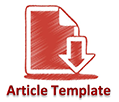Quick Menu
Tentang Jurnal Ini
Focus and Scope
Journalism, Public Relation and Media Communication Studies Journal (JPRMEDCOM) a double-blind peer-reviewed journal, explores critical and constructive inquiries into the wide range of fields of study on Communication Science.
We suggest the following broad areas of research:
- Media, Communication, and Public Policies
- Media and Culture
- Youth and Media Globalisation
- Media and Communication Technology
- Media, Democracy, and Democratisation
- Media and Development
- Health Communication
- Public Relations and Professional Communication Development
- Media, Gender, and Identity
- Social Media and Subculture
- Media, Popular Culture and Society
- Media, Environment, Disaster, Crisis Communication, and Development Studies
- Media and Tourism
- Media, Religion, and Representation
Other papers covering the study of any area pertaining to diversities in media and communication are also welcomed.
Peer Review Process
All articles submitted to Journalism, Public Relation and Media Communication Studies Journal (JPRMEDCOM) must comply with the journal requirements for reviews. They are independently reviewed by two or more external reviewers in the form of double-blind review and assigned by at least one Editor. The reviewers may recommend for publication without revision, with major/minor revision, or rejection. The decision for publication and rejection is based on the reviewers’ reports and recommendations. Under certain circumstances, the editors may require another review before a decision is made.
Section Policies
Journalism, Public Relation and Media Communication Studies Journal (JPRMEDCOM) published in July and DecemberOpen Acces Policies
Journalism, Public Relation and Media Communication Studies Journal (JPRMEDCOM) provides immediate open access to its content. It carries the principle that making research free (downloadable) and available to the public supports a greater global exchange of knowledge.
Publication Ethics
This statement clarifies the ethical behavior of all parties involved in the act of publishing an article in Journalism, Public Relation and Media Communication Studies Journal (JPRMEDCOM) , including the authors, the editors, the peer-reviewers and the publisher (Singaperbangsa University).
Copyright and Permissions
Journalism, Public Relation and Media Communication Studies Journal (JPRMEDCOM) editors and readers have the right to expect that submitted work is the author's own, that it has not been plagiarized (i.e. taken from other authors without permission, if permission is required or proper citation of the original work) and that copyright has not been breached (for example, if figures or tables are reproduced). All the author should agree to our Copyright Notice. All the copyright of this Journal are held by Publisher.
Author Guidelines
1. The Article has not been published in other media. It does not contain an element of plagiarism.
2. The article can be a result of research or conceptual articles or the application of theory, and case reports or book reviews. The article can be written in Bahasa Indonesia or English for 4000 - 10000 words excluding references and tables. The article is computer-typed on A4 paper and single spaced (details of Layout can be referred to our Journal Template). Title text in Bahasa Indonesia consists of 14 words maximally, while for English consists of 12 words maximally.
3. In the article, the author name is attached and the author’s name order must be agreed by all the authors, generally based on the contribution, and all authors are responsible for the content of the article.
5. The article must be along with an abstract in Bahasa and English (for Article written in Bahasa Indonesia) or in English (for Article written in English) with a maximum word count of 250 words in an essay format.
6. The writing format (citation, references) follows the APA Style 7th Edition.
7. Systematics of writing: (a) title, (b) the identity of the author, (c) the date of submission of the manuscript, (d) abstract, (e) keyword, (f) introduction (with no heading and section), (g) discussion, (h) conclusions, (i) bibliography / reference list.








